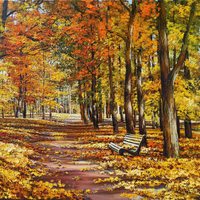Landscape is a popular painting genre that is present in many cultures and artistic traditions with a long history. Landscape painting includes many natural scenes - mountains, rivers, valleys, forests, fields and coastlines. This list was expanded in the 20th century to include urban and industrial landscapes in the definition of landscape. Landscape painters are inspired by the world around them, and while landscape painting is mostly figurative, there was also a tradition of abstract landscapes that developed from the mid-20th century onward. It is believed that artists depict a landscape to capture its beauty or to comment on the relationship between man and the environment.
From the history of landscape
Although some believe that it was Leonardo da Vinci who was the author of landscape painting , this is a common misconception. The history of the landscape can be traced back to China in the 4th century AD, when Chinese artists sought to transfer their impressions of the surrounding nature into paintings. In fact, the genre has become so popular that the beginning of the 9th century is called the dawn of the Chinese landscape.
In Western tradition, it was not always accepted to appreciate nature as such. Landscapes were commonly used as backgrounds for historical paintings or portraits. Landscape in Europe became a popular genre only in the 17th century. There is some evidence of the landscape tradition of Ancient Greece and Rome, but other significant elements besides landscapes were often present in these paintings. Albrecht Altdorfer's Pedestrian Bridge, dating from the early 16th century, is considered the first real landscape in the history of Western art.
During the Renaissance, landscape painting became a serious art genre. From Italy, she came to the rest of Europe, and with the French artists Claude Lorrain and Nicolas Poussin began to dominate. Early European landscapes were highly stylized works of imitation of the landscapes of Ancient Greece and Rome - they were mostly idealized pastoral scenes. Meanwhile, well-known Dutch painters in the 17th century began to develop a more naturalistic style, as can be seen in Art van der Neer's work "Lunar Landscape with a Bridge." in order of importance. This rating demonstrated a rather disdainful attitude of society towards nature at that time. However, in the 18th century, the landscape painting genre really came to life. Its boom in popularity was the result of two factors: the emergence of the idea that nature is a direct manifestation of God on earth, and the rampant industrialization and urbanization of much of Western Europe during the Industrial Revolution. Industry has separated humans from nature, creating a nostalgic desire to glorify the world around us in all its glory. Landscape painting has been described by John Ruskin as "the main artistic creation of the nineteenth century." Nowhere has this tradition been more popular than in Britain, where the Industrial Revolution found its epicenter. Here landscape painting was embodied by two masters of the genre: John Constable and Joseph Mallord William Turner.
Meanwhile, in France, the Impressionists continued this trend and added their own flair to the genre. Artists such as Claude Monet and Pierre Auguste Renoir took a deliberately informal approach, blurring the lines between sketches and finished works. They sketched the scene directly - in the open air - and abandoned traditional techniques such as chiaroscuro and perspective in order to directly embody their own experiences. Soon, in both Britain and France, the traditional hierarchy of genres collapsed, and landscape became one of the most popular forms of painting.
In the early 20th century, the Hudson River School initiated the development of distinctive landscape painting in the United States. It was in the USA that the genre was expanded to include industrial and urban landscapes.
Of the outstanding, world-famous Russian landscape painters, Isaac Levitan, Ivan Shishkin, Ivan Aivazovsky should be mentioned.
Landscape subgenres painting
By the type of motifs depicted, landscapes are divided into numerous categories:
- rural;
- urban;
- architectural;
- mountain, marine, forest, etc.
When classifying by latitude, landscapes are divided into chamber and panoramic.
Depending on the plot, the following types of landscapes are distinguished:
-
epic;
-
historical;
-
heroic;
-
lyric;
-
romantic;
-
fantastic;
-
abstract, etc.
Famous masters and works in the genre of landscape
The masters of landscape who lived in different eras in different parts of the world left their immortal creations to the world:
-
El Greco, View of Toledo;
-
Pieter Bruegel the Elder, Hunters in the Snow;
-
Claude Lorrain, Pastoral Drink

